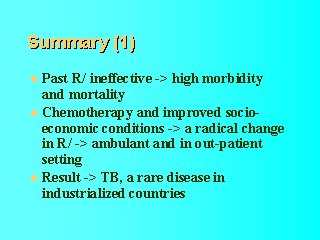| front |1 |2 |3 |4 |5 |6 |7 |8 |9 |10 |11 |12 |13 |14 |15 |16 |17 |18 |19 |20 |21 |22 |23 |24 |25 |26 |27 |28 |29 |30 |31 |32 |review |
 |
Before
the advent of effective chemotherapy, R/ was aimed at relief of symptoms and rest to the
affected organ. Morbidity and mortality were enormous, especially among the smear positive
cases. Extensive, and sometimes mutilating, surgical procedures were carried out in an
attempt to cure the disease. Extensive complications with little benefit were often the
result. The need to control further spread was recognized early, and led to TB clinics. In
the early 1980’s, TB had become a rare disease in the USA, Western Europe and other
industrialized countries due to: *effective anti-tuberculosis drug regimes, *a good functioning TB-control and prevention infrastructure *improved socioeconomic conditions *increased awareness and high priority to overcome the disease. |